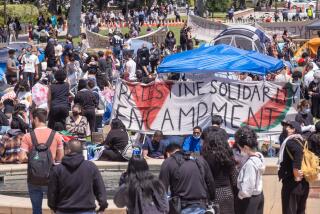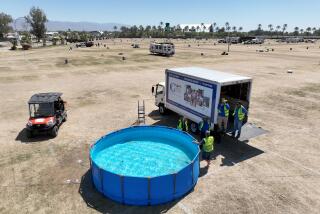DWP Considers Closing Its Aging Sun Valley Plant
The Los Angeles Department of Water and Power is considering closing its San Fernando Valley power plant, despite concerns by some DWP workers that the plant has been serving as the area’s backup power source during emergencies, such as the Northridge quake.
The 1950s-era plant in Sun Valley is the oldest and least efficient power generator of the DWP’s four city plants and DWP officials say closing it would save money because electricity can be purchased more cheaply from other sources.
“If we can provide electricity from other sources at a cheaper price, then that is what we are going to do,” said Rufus Hightower, the DWP’s assistant engineer for power operations and maintenance.
Hightower said the Valley plant is 20% to 25% less efficient in generating power than newer plants, such as the newly modernized DWP station in Wilmington.
But some DWP workers and employee union representatives point out that the Valley plant provided vital power after the Jan. 17 quake knocked out other power sources. Closing it, they say, would eliminate a vital reserve.
“The way we look at it, this plant just saved their bacon,” said Steve Cook, assistant business manager of the electrical workers union that represents DWP employees, including those who work at the plant.
“We live in earthquake country. This is very liable to happen again.”
Hightower said DWP supervisors are aware of the crucial role the Valley plant played after the quake. Because of that, he said, the DWP is conducting a study to evaluate the benefits and drawbacks of closing the plant. The study should be completed in May.
Regardless of the results of the study, Hightower said the consensus among DWP managers is that the plant will close.
The DWP obtains nearly 80% of its power supplies from coal-fired plants in Arizona, Utah and Nevada and hydroelectric plants in the Pacific Northwest. The remaining 20% or so of the power is generated within the city at four natural-gas burning plants.
During the quake, the gigantic network used to import power from plants outside the city was temporarily knocked out, forcing the city to rely heavily on its four local plants to get through the crisis. The Valley plant was the first local station to come on line.
In addition to the Valley plant, the generating stations are the Haynes plant in Long Beach, the Scattergood plant in Playa del Rey and the Harbor plant in Wilmington.
The Valley plant has four generating units, each of which can produce power independently. Just over a year ago, the DWP closed two of those units and now plans to close the other two.
By closing the plant, the DWP could save up to $7 million annually on the cost of operating and maintaining the facility, a DWP official said. The facility employs about 85 workers. They are not concerned about losing their jobs if the Valley station is closed, because most would probably be transferred to other plants, but are genuinely concerned about the supply of power to residents in emergencies, Cook said.
If the plant is closed, it could not be used as an emergency backup because it would take six months to a year to get back in operation, Hightower said.
James Acosta, a shop steward who has worked at the Valley plant for 15 years, said that although the Valley plant is old, it is reliable. He said it would be a mistake to close the plant because it would leave the city vulnerable in another natural disaster.
“In my 15 years I’ve been there . . . the Valley plant has never failed to come on line when needed,” he said. “That is not an exaggeration. It’s like a reliable car that starts whenever you turn the key.”
More to Read
Start your day right
Sign up for Essential California for news, features and recommendations from the L.A. Times and beyond in your inbox six days a week.
You may occasionally receive promotional content from the Los Angeles Times.







